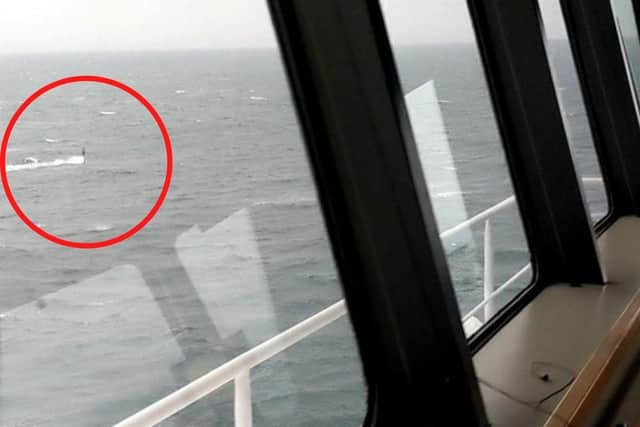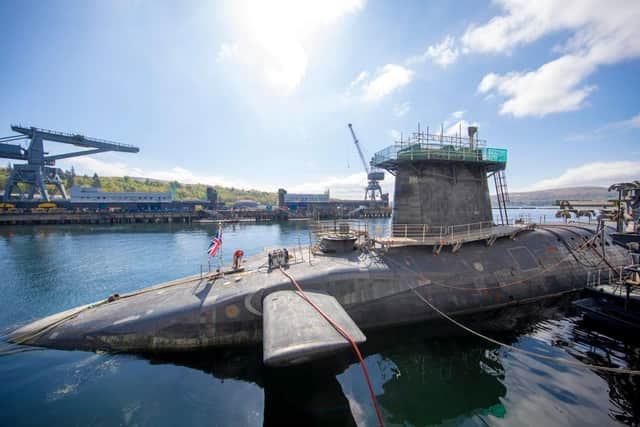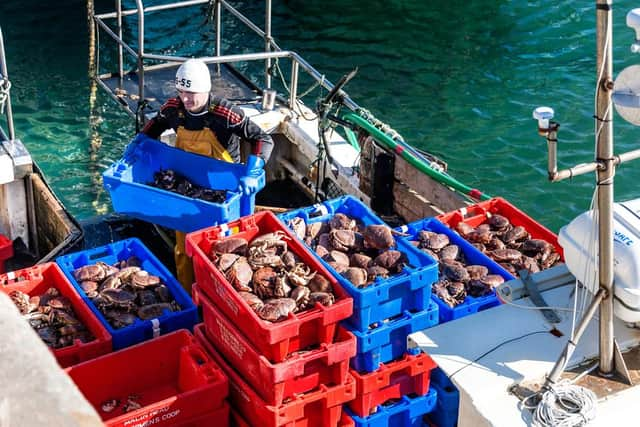Beaufort’s Dyke radioactive dumps prompt calls for action after ferry near miss
The study, carried out by marine radioactivity consultant Tim Deere-Jones on behalf of the UK & Ireland Nuclear Free Local Authorities (NFLA), concluded that use of the Beaufort’s Dyke as a naval submarine training area presented a major safety risk to other vessels in the major shipping route.
It also confirmed that nuclear waste had been deposited in the area, with much of it “short-dumped” outside of the Dyke itself, leading to uncertainty over how much radioactive material lies in the trench.
Advertisement
Hide AdAdvertisement
Hide AdNFLA campaigners described the report as “alarming” and called on authorities in Britain and Ireland to review measures designed to protect ferries, oil tankers and fishing trawlers that operate near the Dyke.


“Coastal communities deserve a review”
Commenting on the NFLA’s latest report, the group’s All Ireland Forum Co-Chair, Councillor Karen McKevitt said: “I welcome this NFLA report as providing coastal councillors like myself with a greater understanding of the ongoing risks and environmental concerns with the Beaufort’s Dyke area of the Irish Sea.
“The report is most helpful in showing how difficult it has been to get the true facts on the amount of dangerous materials which has been dumped into this part of the Irish Sea, and of the real risks that remain in one of the busiest channels of the Irish Sea.
“Given a considerable number of near miss incidents involving nuclear powered submarines and commercial fishing and even passenger vessels, I would encourage the British-Irish Council to review both the safety of this area of deep-water and on how to ensure a reduction in such incidents.


“Coastal communities on both sides of the Irish Sea deserve such a review taking place.”
The NFLA’s Scotland Convener, Councillor Feargal Dalton, added: “Whilst national security is imperative to protect and maintain, the increasing number of near miss incidents between nuclear powered submarines and commercial vessels is alarming.
“The most recent report of the Marine Accident Investigation Bureau of the near miss between a submarine and a passenger ferry was particularly concerning.
“I encourage MSPs, MLAs, MPs and TDs to use our report to ask pointed questions of our governments to improve the health and safety of this critical part of the Irish Sea.”


Advertisement
Hide AdAdvertisement
Hide AdA Ministry of Defence (MoD) spokesperson said: “Wherever Royal Navy submarines operate, we take all appropriate action to ensure the safety of the submarine and other seafarers”
A string of near misses
The report’s findings come after a series of near misses between commercial vessels and nuclear-powered submarines that navigate near the dyke - one of the deepest in the waters around Europe - for testing.
In November 2018, a Stena Line ferry carrying 215 passengers and 67 crew members were placed “in immediate danger” when the ship came within 50 to 100 metres of a submerged Royal Navy nuclear submarine.
The Marine Accident Investigation Branch (MAIB) report into the incident earlier this year revealed that the ferry’s crew only managed to avoid disaster after spotting the submarine’s periscope above the surface of the water.
The UK Department for Transport body said the incident, the third such near miss in four years, was cause for “significant concern”.
It concluded: “This incident happened because the submarine’s control room team overestimated the ferry’s range and underestimated its speed.
“This combination meant the submarine’s commanding officer and its officer of the watch made safety-critical decisions that might have appeared rational to them at the time but were actually based on inaccurate information.”
Andrew Moll, chief inspector at the MAIB recommended the Royal Navy undertake an independent review of the incident “in order to ensure that the risk of similar collisions has been reduced to as low as possible.”
Advertisement
Hide AdAdvertisement
Hide AdBoth the MAIB and the Royal Navy refused to say whether the submarine involved in the near miss was one of the four nuclear-armed Trident vessels based at nearby Faslane.
SNP defence spokesperson Stewart McDonald called on the MoD to “come clean” about whether a nuclear-armed submarine was involved, adding: ‘This had the potential to be a serious maritime disaster.
‘Scotland’s maritime environment cannot continue to be treated with the cavalier attitude that the MoD has become known for.
"We’ve had too many near misses in the past and it’s time ministers took this seriously.”
“A bridge to the moon."
Beaufort’s Dyke made headlines earlier this year when Prime Minister Boris Johnson revived a plan to build a road bridge between Scotland and Northern Ireland.
One proposed route for the bridge, from Larne on the east coast of County Antrim to Portpatrick in Dumfries and Galloway, would pass directly over the dyke.
British Geological Survey work done at the dump site confirmed that explosions generated by degrading munitions are a relatively frequent occurrence.
The Deere-Jones report found that at least one of those explosions was observed to have generated an explosive force equivalent to around 5.5 tonnes of TNT.
Advertisement
Hide AdAdvertisement
Hide AdWriting for the Sunday Times in November, James Duncan, a retired offshore engineer described the so-called Celtic Crossing bridge as "about as feasible as building a bridge to the moon."
But a Downing Street spokesperson said: "The prime minister has said it would have some merit - as a result you would expect the government to be looking into it.
"Work is under way by a range of government officials."
A message from the Editor:
Thank you for reading this article. We're more reliant on your support than ever as the shift in consumer habits brought about by coronavirus impacts our advertisers.
If you haven't already, please consider supporting our trusted, fact-checked journalism by taking out a digital subscription.
Comments
Want to join the conversation? Please or to comment on this article.
